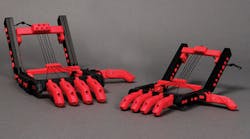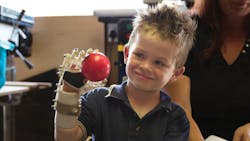Richard Van As didn’t want to become a biomedical engineer. But an accident on the job as a woodworker in South Africa changed his mind. The accident led to the loss of four fingers from one of his hands. Commercial prosthetics cost too much, $10,000 or more per digit, which forced Van As to engineer his own replacements. Fortunately, he soon found a partner, Ivan Own, a theatrical prop designer 10,000 miles away in Seattle who specializes in hands. The two collaborated on various finger designs, slowly improving and tweaking the design, then testing and trying out prototypes, a cycle that took weeks, even months between iterations.
The team quickly concluded they could make much faster progress if they had a 3D printer.
MakerBot Industries LLC, Brooklyn, N. Y., a company that designs and builds desktop 3D printers, eventually heard of Van As and Owen’s plight and donated a pair of its latest machines, the MakerBot Replicator 2 3D printer.
“It was taking weeks and months per cycle to design and craft fingers for Rich,” says CEO of MakerBot, Bre Pettis. “We knew our printer could help them take this important work to new heights, and do so much faster. So we asked them to accept a donation of two MakerBots.”
The two-man design team soon had the prototyping process down to 20 min instead of several weeks.
“The impact of using the MakerBots was incredible,” recalls Owen. “They dramatically increased the speed at which we could try out new ideas and prototype them. And they let us both hold and evaluate physical copies of the latest designs, though we were separated by half a world.”
The designers quickly had the first version of Robohand which modeled after the muscle and tendon structures of crab legs and human fingers. The prosthetic has four fingers that open and close and grasps objects based on wrist motion. When the wrist folds, cables attaching the fingers to the base or frame curl the artificial fingers. It might not have all the functions of $10,000 prosthetic fingers, but then the Robohand only needs about $150 in parts.
After posting online about their success at creating the Robohand, Owen and Van As soon got an e-mail from Liam, a child who lost several fingers to Amniotic band Syndrome. His family could not afford traditional prosthetics, especially since Liam would outgrow any prosthetic in a few months.
Owen and Van As built a custom Robohand sized for Liam. The youngster is now on his second Robohand, having outgrown the first. Other children with ABS in his area saw and heard about his low-cost miracle and wanted one as well.
To help them, and others around the world, Owen and Van As posted all the files needed to 3D-print a Robohand, as well as assembly instructions. Within three months of posting the files and information, more than 3,500 people worldwide downloaded them.
The original design team, as well as a host of volunteer engineers around the world are also still involved. They constantly try to refine the design, making it better but not adding cost.
Stephen Mraz, [email protected]
Resources: MakerBot Industries LLC, Thingverse



